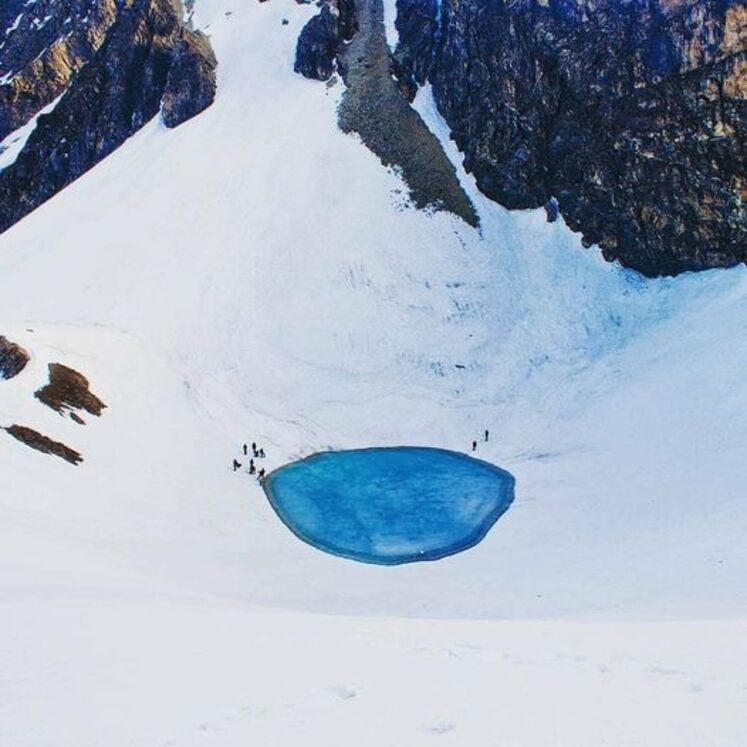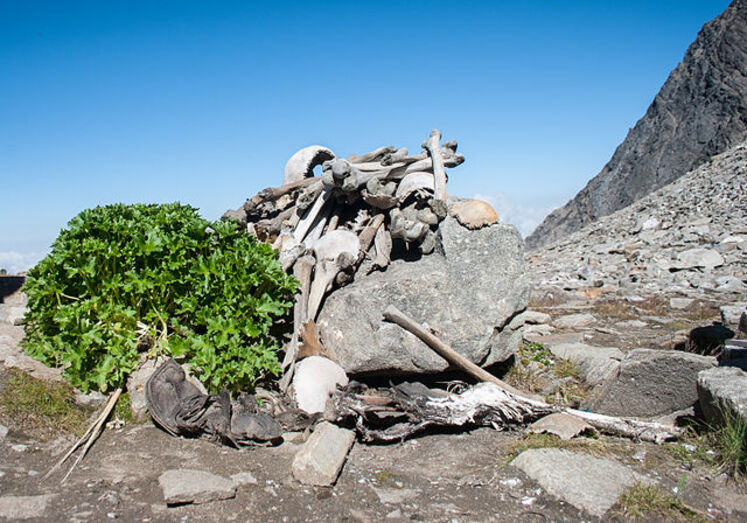New Developments Add More Intrigue to Unsolved Skeleton Discovery in Indian Lake
Close to 800 skeletons lie in a frozen lake in India. Roopkund Lake, commonly known as the Lake of Skeletons, lies on one of India’s highest mountains. A British forest ranger discovered it in 1942, and scientists have been baffled by it ever since.
Who were these people, and how did they die? An expedition in 2004 provided the answers, and you are about to learn them.
A Beautiful Sight
Skeleton Lake sits 16,000 feet above sea level below a tiny valley in the mountains. Any hiker trekking by would be anxious to get a closer look. But depending on the time of year, they’d be in for a gruesome surprise.

Source: Wikimedia Commons
That’s what happened in 1942 when a British forest guard, hiking nearby, saw the beautiful lake and wanted a closer look. Peering into the water, he realized he was looking at human skeletons. Although he didn’t know it at the time, over 200 were full skeletons.
Why Had No One Found These Before?
The Lake remains frozen for most of the year. As it freezes and melts, it expands or shrinks. Thus, only during the few times of the year when the weather is not frigid can one actually see what is in the lake.

Source: Lost Temples/Facebook
It just so happened that the British forest guard was hiking during the warmer time of year when the lake was not completely frozen over. Thus, he was able to get close to peer into the water. That’s when he found almost 800 remains.
The Questions Begin
As soon as the British guard reported the finding, scientists and anthropologists around the world wanted to know more. There was a fury of speculation about who these people were and when and how they died.

Source: Uttarakhand Panorama/Facebook
One theory was that this was a troop of Japanese soldiers who died trying to make their way through the mountains in 1841. Yet another was that these were the remains of an Indian king, his family, and his attendants who died in a blizzard 870 years before.
Were They Japanese Soldiers?
In the 1840s, the British empire ruling India was concerned that the Japanese would invade the country by hiking through the mountains. There were many ways that an invading force could enter India, and this was one of them.

Source: Elemental Podcast/Facebook
The British sent a team of scientists to the lake when the discovery was made to see if these were actually the remains of Japanese soldiers. However, the study determined that the bones were too old to fit that particular theory.
More Theories
Yet another theory was that these were the remains of Indian soldiers who tried to invade Tibet in 1841. These soldiers were overwhelmed by Tibetan forces and had to retreat. Their retreat took them over the Himalayas, so perhaps they perished at the lake.

Source: Wikimedia Commons
Or, perhaps, these were victims of an epidemic who were buried in the lake. In nearby villages, a popular folk song tells the story of a hail storm that killed people near the lake.
Eerie and Well-Preserved
Located in the cold, dry air in the high altitude setting, some of the skeletons were amazingly well preserved. Upon closer investigation, scientists found that many still had hair, bone, and flesh that looked quite recent.

Source: Wikimedia Commons
Further study revealed that the skeletons were quite old, and researchers were not able to determine how all of these people died in the same spot. More study was needed, which revealed some fascinating details.
Some Fascinating Details
Researchers determined that most of the dead were taller than average. It was also determined that they were middle-aged, about 35-40 years old, and were from a single group that died together during some kind of catastrophe.

Source: Wikimedia Commons
A detailed study of the almost 800 sets of bones determined that none of the dead were infants or children, and some were older women. All seemed to be in good health, but these studies were all going to be disproved years later.
The 2004 Study
The first thorough scientific report about the skeletons came out in 2004. At that time, the researchers took DNA samples for study at the Centre for Cellular and Molecular Biology in India.

Source: Hinterhaus Productions/Getty Images
These researchers disproved many earlier theories, determining that the people were not part of an army since no weapons were found. Also, they were not traders since no animals were found. Thirdly, they did not suffer from illness.
More Fascinating Findings
According to these scientists, the bodies date to around 850 A.D. Also, there seemed to be two separate groups of people killed at this spot. One was a family group, and the second was a group of smaller people. These scientists studied over 200 skeletons.

Source: HoolooVee/Reddit
It seemed very likely that the dead consisted of a family going through the mountains for some reason, who were killed along with their porters or guides whom they had hired to help them.
How Did They Die?
All the bodies had the same type of sounds, indicating blows to the head and shoulders. It seemed that the head injuries were not caused by weapons but by some kind of round object.

Source: PeepulTreeWorld/Twitter
With most of the injuries being on the heads and shoulders, scientists theorized that whatever killed them came from above. Something fell upon them in a way that did such serious damage to their heads that it killed them.
Was It The Goddess?
A Himalayan folk song tells of a goddess who was angry at a group of people who had invaded her mountain and defiled it. Her anger was legendary, and the story goes that she decided to wreak vengeance upon the invaders.

Source: eng-news.ru
The song goes on to tell the story that the goddess threw stones from the sky onto the invaders. Scientists assume that this song refers to a sudden and very dangerous hailstorm that hit the travelers and pounded them, killing them.
An Epic Hailstorm
These poor people were caught on a mountain with nowhere to run and hide. The hailstones were described in the folk song as “hard as iron.” Scientists estimate that the hail could have been at least 9 inches wide.

Source: CaffeinatedLoserr/Reddit
As the hailstones fell by the thousands for hours, pounding the travelers, these unfortunate people were literally killed where they stood. The remains of these poor travelers lay in the lake for over 1,200 years until the British guard discovered them.
The Five-Year Study Digs Deeper
The research into the eerie finding from 1942 did not stop after the 2004 study. A group of 28 scientists began a five-year-long study in 2014 to use more up-to-date research techniques, such as carbon dating, to find out more.

Source: CaffeinatedLoserr/Reddit
In 2019, Nature magazine published the results of the study, written by 28 authors from 16 research centers in India, the U.S., and Germany. Many of their findings disputed what had been revealed in earlier research.
Carbon-Dating The Bodies
The newer scientific methods revealed a good deal more information about the skeletons. The lead author of the study, Eadaoin Harney, shocked the anthropological and scientific community when he stated, “It upends any explanations that involved a single catastrophic event that lead to their deaths.”

Source: Wikimedia Commons
Harney further stated, “It is still not clear what happened at Roopkund Lake, but we can now be certain that the deaths of these individuals cannot be explained by a single event.” It seemed that the hailstorm theory had been put to bed.
Where Did These People Come From?
The newer study provided fascinating detail about the origins of this group. It found that the victims came from diverse areas, some from South Asia and others from Europe, particularly from Crete.

Source: Atlas Obscura/Pinterest
Also, the people from South Asia do not appear to come from the same population. “Some of them have ancestry that would be more common in groups from the north of the subcontinent, while others have ancestry that would be more common from more southern groups,” says Ms. Harney.
When Did They Get There?
The new research revealed some interesting data. Using genetic analysis, they found that two different groups arrived, separated by less than 1000 years. One group got to the location between the 7th to 10th centuries.

Source: Wikimedia Commons
The other group arrived anywhere from the 17th-20th centuries. This means that obviously, the groups died in separate events. But what is strange is that most had the same type of head and shoulder injuries!
Revelations About Their Diets And Ancestry
The Nature article from 2019 also revealed, through the study of the skeleton bones, that the two groups had very different diets. This would indicate that they came from separate locations in the world.

Source: Wikimedia Commons
Some people ate mostly from the local animals, but others mostly vegetable and plant-based foods such as wheat, barley, and rice, or animals that ate those foods. Ancestry research indicated that one group was from Western South Asia and one from Eastern South Asia.
Why Were They There?
So, we have a diverse group from different areas of the world. Did they travel together for some reason, or did they travel by themselves over a period of several hundred years? Also, did some of them actually die during a single tragic event?

Source: Gerry Roberts/Pinterest
Since no weapons or trading materials were found, and the lake is not on a trade route, it is unlikely that these were tradesmen or soldiers. The genetic studies didn’t find any evidence of some kind of disease, so they didn’t die from an epidemic.
The Conclusion Of The 28 Scientists
The Nature article concluded that one group was on a pilgrimage, gathering for worship and celebration along the route of the lake. Inscriptions found in temples along the route helped with that conclusion. Perhaps this was a mass death during the pilgrimage.

Source: Peak Adventure Tour/Pinterest
As for the second group, it seems that these individuals were not part of a related group, but were born in the eastern Mediterranean, probably in Crete. There is no data as to why they ended up at the lake.
We Still Don’t Know
There are still so many questions that are left unanswered. How did people from the Eastern Mediterranean get to one of the highest mountains in India? Was there a group of people who found their way to this spot and decided to live there?

Source: anaqunha/Reddit
The mystery lives on, despite years of study. As the findings come out, there are even more questions left unanswered. Hopefully, groups of anthropologists and scientists will continue to study this bizarre story. As Ms. Harney says, “We are still searching for answers.”
